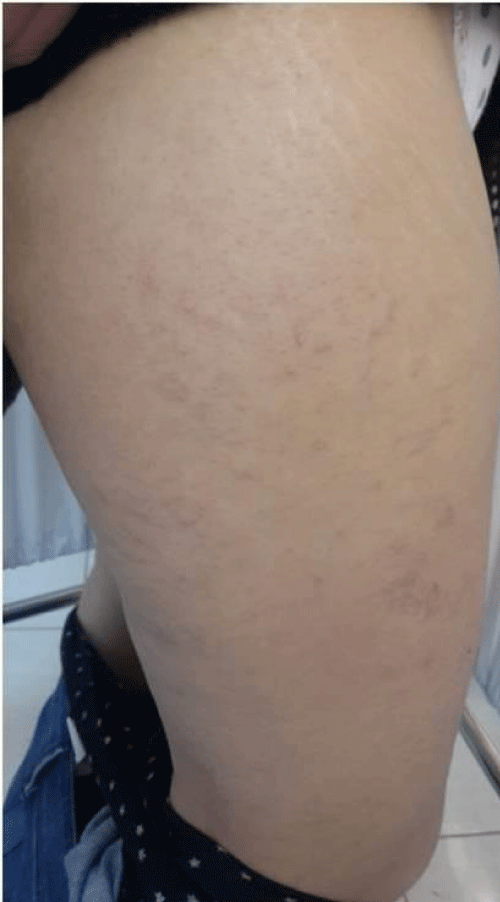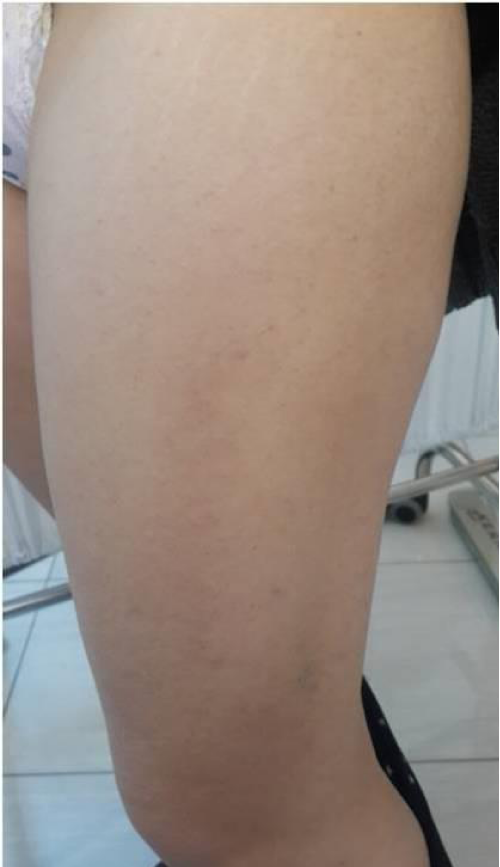More Information
Submitted: 24 April 2020 | Approved: 20 May 2020 | Published: 21 May 2020
How to cite this article: El Amraoui M, Frikh R, Hjira N, Boui M. Bee venom: a case of effectiveness on skin varicosities veins with review of its dermatological benefits. Ann Dermatol Res. 2020; 4: 006-008.
DOI: 10.29328/journal.adr.1001010
Copyright License: © 2020 El Amraoui M, et al. This is an open access article distributed under the Creative Commons Attribution License, which permits unrestricted use, distribution, and reproduction in any medium, provided the original work is properly cited.
Keywords: Bee; Venom; Efficacy; Skin varicosities; Dermatological benefits
Bee venom: a case of effectiveness on skin varicosities veins with review of its dermatological benefits
Mohamed El Amraoui*, Rachid Frikh, Naoufal Hjira and Mohammed Boui
Dermatology department, Mohammed V Military Teaching Hospital, Rabat, Morocco
*Address for Correspondence: Mohamed El Amraoui, Dermatology Department, Mohammed V Military Teaching Hospital, Rabat, Morocco, Email: [email protected]
Bee venom is a very rich and varied biochemical complex, which explains the multitude of its physiological effects as well as its medical indications. In dermatology, apart from psoriasis, few studies have been conducted concerning its interest and effectiveness; however the preliminary results remain so promising and encouraging. We present a clinical case illustrating the efficacy of bee venom in cutaneous varicosities, with a review of the literature of its main dermatological indications.
Bee venom has been known for long time for its therapeutic virtues and its indications are constantly expanding in various fields, particularly in dermatology and aesthetic medicine, as this clinical case shows.
33 year old young woman, teacher by profession, married and mother of 3 children, followed in our department for androgenetic alopecia under platelet rich plasma sessions. The patient also presents varicosities of both thighs for which she tried herself bee stings first on the left thigh with respect for the right thigh. The technique she used is to stock up on bee in a beekeeper, to be stung by 3 bees, 3 bites of 30 seconds, 3 cm apart on the varicose veins and repeated every 15 days with 3 sessions in total. The result obtained was clearly significant with acceptable tolerance and satisfaction (Figures 1,2).
Figure 1: Varicosities of the skin in the right thigh (untreated).
Figure 2: Significant improvement of cutaneous varicosities of the left thigh after three sessions of bee venum therapy.
The use of bee products for therapeutic purposes has been known since antiquity as shown by historical and prehistoric evidence [1]. The venom of the bee and thanks to its composition so rich and varied has several physiological effects: antiaggregant, antihypertensive, tonicardiaque, analgesic, antipyretic, anti-infectious, immunostimulant, anti-inflammatory, anti-radical, anti-cancer and stimulates the general tone [2]. From these effects flow its main indications in several disciplines, particularly in rheumatology in neurology and cardiology [3].
In dermatology few studies have been conducted with a relative frequency of sporadic and anecdotal cases. Of which the main ones showed the effectiveness of apipuncture alone or associated with api therapy (propolis) in psoriasis with a decrease in the PASI score and a decrease in serum levels of TNF-α [4-6].
Varicose veins and cutaneous varicosities are a frequent reason for consultation in dermatology and cosmetology. In addition to vascular lasers, sclerotherapy is a therapeutic means with its advantages and limits. Few publications have highlighted the interest of venoms as sclerosing products, in particular spiders and bees venoms. The mechanism of action in this indication is not fully known but thanks to its rich composition bee venom accelerated blood flow velocity, removes spasms in peripheral vessels, decreases blood clotting and observed the removal of pain.
Concerning the pigment disorders, the bee venom seems to intervene as well in the negative and positive regulation of the melanogenesis, thus according to certain authors and in addition to its anti-aging and brightening effect, the venom of bee inhibits the enzymes of melanogenesis including tyrosinase and tyrosinase-related protein 1 and 2 (TRP-1 and TRP-2) and inhibit the effect of alpha MSH on melanoma B16F1 cells [7-20], and according to other authors, bee venom stimulates proliferation of human melanocytes, melanogenesis, proliferation of dendrites and migration and transfer of melanosomes [8].
Other studies highlight the interest of bee venom in the treatment and prevention of eczema and atopic dermatitis and the interest of emollient containing bee venom in the maintenance of remissions [9,10,17-19].
Sporadic studies show the interest of bee venom in the improvement of acne lesions, in the treatment of onychomycosis and in the regulation of the immune system in general [11-13].
Thanks to its anti-inflammatory and anti-fibrotic effect, bee venom can be tested in dermatoses with fibrosating properties, especially in morphs and cheloids [14,20].
While the indications of bee venom in cancerology are limited and controversial, cases of cure of some benign skin tumors leave hope with prospects in the future [15].
The interest of skin venom in skin rejuvenation finds its place in the field of explosion of aesthetic and anti-aging medicine with the placing on the market of multiple products and processes based on bee venom [16].
Bee venom is a very rich biochemical complex with multiple effects and indications. In dermatology, this therapeutic field remains so little explored that very promising.
Statement of ethics
The examination of the patient was conducted according to the Declaration of Helsinki principles. The authors certify that they have obtained all appropriate patient consent forms. In the form the patient(s) has/have given his/her/their consent for his/her/their images and other clinical information to be reported in the journal. The patients understand that their names and initials will not be published and due efforts will be made to conceal their identity, but anonymity cannot be guaranteed.
- Fratellone PM. Apitherapy Products for Medicinal Use. J Nutr Food Sci 5: 423.
- Kintz P, Villain M. Therapeutic use of venom from bees: science or scam. Ann Toxicol Anal. 2011; 23: 37-39.
- Fratellone PM. Apitherapy Products for Medicinal Use. J Nutr Food Sci 2015; 5:6
- Hegazi AG, Abd Raboh FA, Ramzy NE, Shaaban DM, Khader DY. Bee venom and propolis as new treatment modality in patients with localized plaque psoriases. Int Res J Med Medical Sci. 2013; 1: 27-33.
- Eltaher S, Mohammed GF, Younes S, Elakhras A. Efficacy of the apitherapy in the treatment of recalcitrant localized plaque psoriasis and evaluation of tumor necrosis factor-alpha (TNF-α) serum level: A double-blind randomized clinical trial. J Dermatolog Treat. 2015; 26: 335-339. https://pubmed.ncbi.nlm.nih.gov/25424047/
- El–Gammal E, Di Nardo V, Daaboul F, Tchernev G, Wollina U, et al. Apitherapy as a New Approach in Treatment of Palmoplantar Psoriasis. Open Access Maced J Med Sci. 2018; 6:1059-1061. https://www.ncbi.nlm.nih.gov/pmc/articles/PMC6026437/
- Han SM, Kim JM, Pak SC. Anti-melanogenic properties of honeybee (Apis mellifera L.) venom in α-MSH-stimulated B16F1 cells. Food and Agricultural Immunology. 2015; 26: 451–462.
- Jeon S, Kim NH, Koo BS, Lee HJ, Lee AY. Bee venom stimulates human melanocyte proliferation, melanogenesis, dendricity and migration. Exp Mol Med. 2007; 39: 603-613. PubMed: https://pubmed.ncbi.nlm.nih.gov/18059136/
- Park KK. Therapeutic effects of melittin on ovalbumin-induced atopic dermatitis mouse model. J Clin Exp Dermatol Res. 2017, 8:4 (Suppl).
- You CE, Moon SH, Lee KH, Kim KH, Park CW, Seong Joon Seo, Sang Hyun Cho. Effects of Emollient Containing Bee Venom on Atopic Dermatitis: A Double-Blinded, Randomized, Base-Controlled, Multicenter Study of 136 Patients.
- Han SM, Pak SC, Nicholls YM, Macfarlane N. Evaluation of anti-acne property of purified bee venom serum in humans. J Cosmet Dermatol. 2016; 15: 324—329. PubMed: https://pubmed.ncbi.nlm.nih.gov/27216488/
- Park J, Kwon O, An HJ, KK Park. Antifungal Effects of Bee Venom Components on Trichophyton rubrum: A Novel Approach of Bee Venom Study for Possible Emerging Antifungal Agent. Ann Dermatol. 2018; 30: 202-210. PubMed: https://pubmed.ncbi.nlm.nih.gov/29606818/
- Lee WR, Pak SC, Park KK. The Protective Effect of Bee Venom on Fibrosis Causing Inflammatory Diseases.Toxins. 2015; 7: 4758-4772. PubMed: https://www.ncbi.nlm.nih.gov/pmc/articles/PMC4663532/
- Ravid E. Skin tumors treatment via bee venom. Natural Chemotherapy
- Han SM, Hong IP, Woo SO, Chun SN, Park KK, et al. The beneficial effects of honeybee-venom serum on facial wrinkles in humans. Clin Interv Aging. 2015; 10: 1587–1592. PubMed: https://www.ncbi.nlm.nih.gov/pmc/articles/PMC4598227/
- Gu H, Kim WH, An HJ, Kim JY, Gwon MG, et al. Therapeutic effects of bee venom on experimental atopic dermatitis. Mol Med Rep. 2018; 18: 3711-3718. PubMed: https://www.ncbi.nlm.nih.gov/pmc/articles/PMC6131226/
- Jung KH, Baek H, Kang M, Kim N, Lee SY, et al. Bee Venom Phospholipase A2 Ameliorates House Dust Mite Extract Induced Atopic Dermatitis Like Skin Lesions in Mice. Toxins. 2017; 9: 68. PubMed: https://www.ncbi.nlm.nih.gov/pmc/articles/PMC5331447/
- An HJ, Kim JY, Kim WH, Gwon MG, Gu H, et al. Therapeutic effects of bee venom and its major component, melittin, on atopic dermatitis in vivo and in vitro. Br J Pharmacol. 2018; 175: 4310-4324. PubMed: https://pubmed.ncbi.nlm.nih.gov/30187459/
- Lim HN, Baek SB, Jung HJ. Bee Venom and Its Peptide Component Melittin Suppress Growth and Migration of Melanoma Cells via Inhibition of PI3K/AKT/mTOR and MAPK Pathways. Molecules. 2019; 24: 929 PubMed: https://pubmed.ncbi.nlm.nih.gov/30866426/
- Hwang JH, Kim KH. Bee venom acupuncture for circumscribed morphea in a patient with systemic sclerosis Medicine (Baltimore). 2018; 97: e13404. PubMed: https://www.ncbi.nlm.nih.gov/pmc/articles/PMC6310600/

